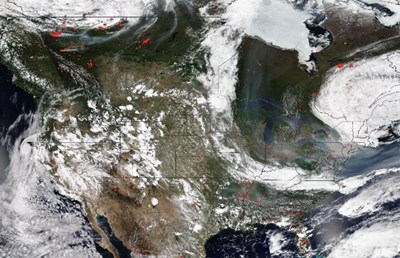CISESS Seed Grant: Wildfire Smoke Early Warning: Using Earth Observations to Improve Health Interventions
April 14, 2025 10:14 AM

Figure: Long-range transport of Canadian wildfire smoke to the central and eastern United States: active fire points and smoke plume observed from NOAA-20 VIIRS on 7 June 2023.
© NOAA Satellites
Evan Ellicott, Associate Research Professor, UMD Department of Geographical Sciences
Wildfire events generate an enormous amount of smoke, ejecting a combination of gases and particulate matter into the atmosphere that can travel long distances. Wildfire smoke poses a number of risks, from visibility concerns for aviation to human health impacts. For example, fine mode particulate matter (aerodynamic diameter less than 2.5 microns, called PM2.5) can enter the human bloodstream via the lungs and result in cardiovascular damage. At-risk segments of the population, such as the elderly, infants, and young children, are more vulnerable during smoke events. Individuals already diagnosed with respiratory and heart disease are more likely to need health intervention when exposed to wildfire smoke.
Wildfires in the U.S. and Canada have become larger and more intense, often displaying extreme behavior. Coupled with increased temperatures and drought, North America has witnessed the emergence of “megafires” (>40,500 ha). The Smokehouse fire in Texas last year (2024) burned an astonishing 1.1 million acres while 8 of the largest fires in California history have occurred since 2017. Colorado has seen the 20 largest fires in state history occur since 2001 with nine of these since 2018. In 2023, Canada witnessed over 17 million hectares burn, approximately eight times the 40-year average (1983-2022). The Canadian wildfires transported smoke to the central and eastern portions of the U.S. causing dangerous levels of air pollution while highlighting the reach and impact wildfires can have beyond their proximate location (see Figure). Our research, recently published in the Journal of American Medical Association (JAMA), demonstrated significant increase in ambulatory clinic, inpatient or emergency clinical encounters for cardiopulmonary disease in Maryland during June 2023 when wildfire smoke impact was greatest.
Our CISESS Seed Grant Project is developing a wildfire smoke early-warning system using Earth observations, modelled data, and ground measurements to enable timely deployment of clinical support resources to high-risk areas in Maryland. Such a system would have clear benefits to mitigate health care impacts as a result of wildfire smoke events. The alert system will be developed in partnership between the University of Maryland College Park, University of Maryland School of Medicine and University of Maryland Institute for Health Computing (IHC). We are also working with the Renal Research Institute and the Fresenius Kidney Care (FKC) dialysis clinics. Our system architecture will allow transfer of knowledge (code, data sources, etc.) to other regional, state, or municipal systems. The expected science would demonstrate the assimilation of various ground and remotely sensed data for a targeted cause and audience and highlight the effectiveness of Research-to-Operations (R2O).
We are currently standing up a server to host GeoServer, ingest wildfire activity, including locations, size, and intensity (as estimated from satellite fire radiative power). We will also be ingesting High-Resolution Rapid Refresh Smoke model runs and performing our own modelled smoke trajectories using the Hybrid Single-Particle Lagrangian Integrated Trajectory (HYSPLIT) model. Our web dashboard will offer real-time situational awareness of fire and smoke activity in North America and will allow users to subscribe to receive notifications via text or email when a smoke event is imminent (~ 2 days out).
« Back